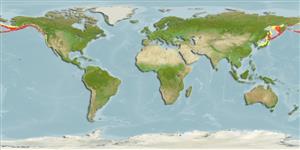Environment: milieu / climate zone / depth range / distribution range
Ökologie
seewasser demersal; tiefenbereich 0 - 720 m (Ref. 114138). Boreal; 64°N - 34°N, 130°E - 118°W
North Pacific: between the middle Kuril Islands and Gulf of Alaska; including off the coast of Eastern Sakhalin, in the north of the Sea of Okhotsk, waters of Hokkaido, southern Kuril Is., and to the north up to Anadyr Bay. In the Sea of Japan, found once in northern Primorye and caught south of Moneron I. and in the open part of Peter the Great Bay (Ref. 114081). Southward range up to Redondo Beach, California (Ref.
Length at first maturity / Size / Gewicht / Alter
Maturity: Lm 32.5 range ? - ? cm
Max length : 56.5 cm TL Männchen/unbestimmt; (Ref. 56527); 35.0 cm SL (female); max. veröff. Gewicht: 2.0 kg (Ref. 56344); max. veröff. Alter: 15 Jahre (Ref. 55701)
Rückenflossenstacheln (insgesamt): 21; Rückenflossenweichstrahlen (insgesamt): 25-29; Afterflossenstacheln 1; Afterflossenweichstrahlen: 24 - 26; Wirbelzahl: 59 - 60. Adults with 5 broad blackish bands on body (Ref. 559).
This species is found at the demersal zone and near surface over reefs and hard bottoms from intertidal zone to about 2.360 ft (719.8 m). It is preyed upon by other fishes, sea birds and marine mammals (Ref 114183).
Spawns twice a year (Ref. 28499). Eggs are deposited in rock crevices and are guarded by the male who continuously fans the egg mass with his pectoral fin until hatching (Ref. 28499), which occurs after 40-45 days (Ref. 27369).
Eschmeyer, W.N., E.S. Herald and H. Hammann, 1983. A field guide to Pacific coast fishes of North America. Boston (MA, USA): Houghton Mifflin Company. xii+336 p. (Ref. 2850)
IUCN Rote Liste Status (Ref. 130435)
Bedrohung für Menschen
Harmless
Nutzung durch Menschen
Fischereien: kommerziell
Mehr Information
PartnerBilderStamps, Coins Misc.LauteCiguateraGeschwindigkeitSchwimmstilKiemenoberflächeOtolithsGehirngrößeSehfähigkeit
Tools
Zusatzinformationen
Download XML
Internet Quellen
Estimates based on models
Preferred temperature (Ref.
123201): 0.7 - 6.1, mean 3.7 °C (based on 359 cells).
Phylogenetic diversity index (Ref.
82804): PD
50 = 0.7502 [Uniqueness, from 0.5 = low to 2.0 = high].
Bayesian length-weight: a=0.00933 (0.00479 - 0.01820), b=3.05 (2.87 - 3.23), in cm total length, based on LWR estimates for this species & (Sub)family-body (Ref.
93245).
Trophic level (Ref.
69278): 3.4 ±0.0 se; based on diet studies.
Widerstandsfähigkeit (Ref.
120179): niedrig, Verdopplung der Population dauert 4,5 - 14 Jahre. (K=0.28; tm=3.6; tmax=15).
Prior r = 0.18, 95% CL = 0.10 - 0.36, Based on 3 stock assessments.
Fishing Vulnerability (Ref.
59153): Low to moderate vulnerability (30 of 100).
Climate Vulnerability (Ref.
125649): Moderate to high vulnerability (52 of 100).
Nutrients (Ref.
124155): Calcium = 14.2 [8.0, 61.2] mg/100g; Iron = 0.575 [0.216, 1.388] mg/100g; Protein = 18.5 [15.8, 20.7] %; Omega3 = 0.563 [0.245, 1.648] g/100g; Selenium = 22.1 [10.0, 53.8] μg/100g; VitaminA = 7.08 [1.69, 29.21] μg/100g; Zinc = 0.477 [0.224, 0.884] mg/100g (wet weight); based on
nutrient studies.
